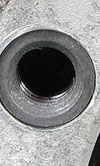Thread Inserts (3)
 Continuing the discussion of wire thread inserts in previous articles, this month I'll consider 'solid' types of insert. There are at least two varieties of 'solid' inserts in common use, and these are used mainly for repairs and, less often, in situations where female thread strength is felt to be a problem and that without such an insert, the chances of thread stripping are high.
Continuing the discussion of wire thread inserts in previous articles, this month I'll consider 'solid' types of insert. There are at least two varieties of 'solid' inserts in common use, and these are used mainly for repairs and, less often, in situations where female thread strength is felt to be a problem and that without such an insert, the chances of thread stripping are high.
The 'problem' with solid inserts is that they can (and generally do) bias the distribution of load towards the first engaged threads, leading to a higher stress concentration factor for the male threaded part. This is because, almost without exception, they are installed in parts made from materials with a low elastic modulus.
But since these will be used in most instances as a repair scheme, should we consider this a problem? In most cases the answer will be no. Clearly it is the female thread that is the weaker of the two in these cases, and even though we will cause a worse load distribution in the male threaded component, it is often preferable to scrapping an otherwise serviceable cylinder head, for example. It would be rare to find that the male threaded component would have such a marginal factor of safety in these circumstances, such that fitting an insert would transfer failure to the screw, bolt or spark plug for example.
Solid inserts are generally equipped with a self-locking feature which means that replacing them can be difficult. The popular 'Timesert' solid thread insert is one such component, and the locking mechanism relies on deforming the bottom thread of the insert radially outwards, locking it in place. The insert has a flange at the outer end, and the installation tool flares the lower part of the insert once the flange has 'bottomed'. These inserts are a popular repair for stripped spark-plug threads, and special kits are sold for this purpose for some popular models of cars.
There is another kind of insert which is locked in place by a more aggressive mechanical feature. 'Keenserts' are solid inserts with square-section locking 'keys' cleverly located in the sides of the inserts. Once the insert is installed to the correct depth, the keys, which are designed so that they have a cutting action as they are installed, are hammered into place, firmly locking the insert in position. The Keensert is primarily designed for insertion into low-strength materials owing to the requirement to force the 'keys' into place.
As repair schemes, both types work on the principles of first removing the damaged female thread and then enlarging it. The enlargement means that the thread in the casting in undamaged material and the area of the thread in shear is increased, thereby increasing the load capacity of the female thread in the casting. The bolt is installed in a female thread of higher strength material and therefore, even though we have replaced one female thread with two, the chances of either failing are very low.
Fig. 1 - The picture shows a 'timesert' installed in an aluminium casting
Written by Wayne Ward